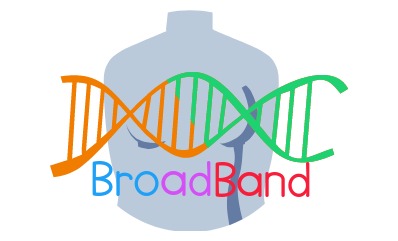

The third panel is focused on somatic copy number aberrations data, this panel provides a full report about the frequencies of somatic copy number aberrations occurring in genomic regions of different ranges. Specifically, aberrations occurring in gene, chromosomal cytobands and chromosomal arms, are computed based on molecular features, tumor classification of available data included in the selected cohorts.
The widget panel (Figure 3A) is populated with multiple selection options which will update the BRCA data displayed by default. Specifically, the widget panel allows the user to: 1. Upload a new BRCA dataset to be inspected in addition to those ones available by default. The cancel button will reverse the operation by removing the uploaded dataset among available data. 2. Select BRCA cohorts of interest. If the user uploaded a custom dataset, it will be listed here. 3. Select data based on BRCA subtypes. 4. Select data based on tumor classification. 5. Set granularity of SCNAs event. The user can select to compute and report the frequencies of aberrations based on 2 classes of aberrations: amplifications and deletion events or, alternatively, on 4 classes: homozygous deletion, hemizygous deletion, gain, and amplification events. 6. Select the SCNAs event of interest to be displayed. 7. Apply a threshold on aberration frequencies by using the provided slider. 8. Select the chromosome of interest to be displayed. 9. Select the cytoband of interest to be displayed. 10. Reset all settings to default. 11. Apply selected options to data and update plots and tables accordingly. In addition to the widgets bar, the page layout also includes two plots, a table and five downloads buttons which allow the user to save all outputs displayed. The plots and the tables are the results of all options selected by the user. The first plot is a set of bar charts, one for each chromosome, to provide a landscape of SCNAs frequencies of aberrations. In the second plot the user can select a chromosome of interest to get a closer look at the frequencies of aberration across the chromosome cytobands. The third plot reports, within a selected cytoband of interest, the frequency of aberrations at the gene level. A gene is highlighted (Figure 3D) if it is a known cancer driver gene. Genomic location information (Figure 3B, 3C) and BRCA dataset used to compute frequencies of aberrations displayed (Figure 3C, 3D) are reported in the plot legend.